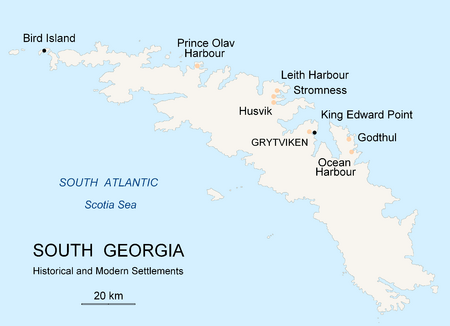Ocean Harbour facts for kids
Ocean Harbour (also called Spanish: Puerto Nueva Fortuna) is a deep bay on the north coast of South Georgia. It's located about 1.5 miles (2.4 km) west-northwest of Tijuca Point. This area was once a very busy place for whaling.
From 1909 to 1920, Ocean Harbour was a major whaling station. At one point, the entire island of South Georgia was known as the "whaling capital of the world."
The bay has had a few different names over time. In 1922, explorers from the German Antarctic Expedition called it "New Fortune Bay" or "Neufortuna Bay." These names likely came from a whaling ship named Fortuna. This ship belonged to a Norwegian-Argentine whaling company called Pesca.
Later, in 1951–52, a group called the South Georgia Survey explored the island. They found that whalers and sealers already called the place Ocean Harbour. This name came from the Ocean Whaling Co., which used to have a station there. The name Ocean Harbour was officially approved to avoid confusion with another nearby place called Fortuna Bay.
Contents
History of Ocean Harbour
Ocean Harbour has a rich history, especially linked to whaling and sealing. You can still find old "trypots" there. These were large pots used to boil down seal blubber to make oil.
The Shipwreck of the Bayard
A famous shipwreck is also found here: the Bayard. This was a large iron ship, built in 1864, that weighed 1,300 tonnes and was about 67 meters (220 feet) long. In 1911, the Bayard was tied up at a coaling station in the harbour. A strong storm blew her loose, and she drifted across the bay, becoming a wreck.
Reindeer on South Georgia
Ocean Harbour was also the first place where reindeer were brought to South Georgia. In November 1911, Carl Anton Larsen, who managed Pesca's whaling station, and his brother introduced the reindeer to the island.
The Oldest Grave
The harbour also has a small cemetery with eight graves. One of these is the oldest known grave on South Georgia. It belongs to Frank Cabrial, who died in 1820. He was from a sealing ship called the Francis Allen. While his marker is gone, some of the other graves are still marked.
See also
 In Spanish: Puerto Nueva Fortuna para niños
In Spanish: Puerto Nueva Fortuna para niños



